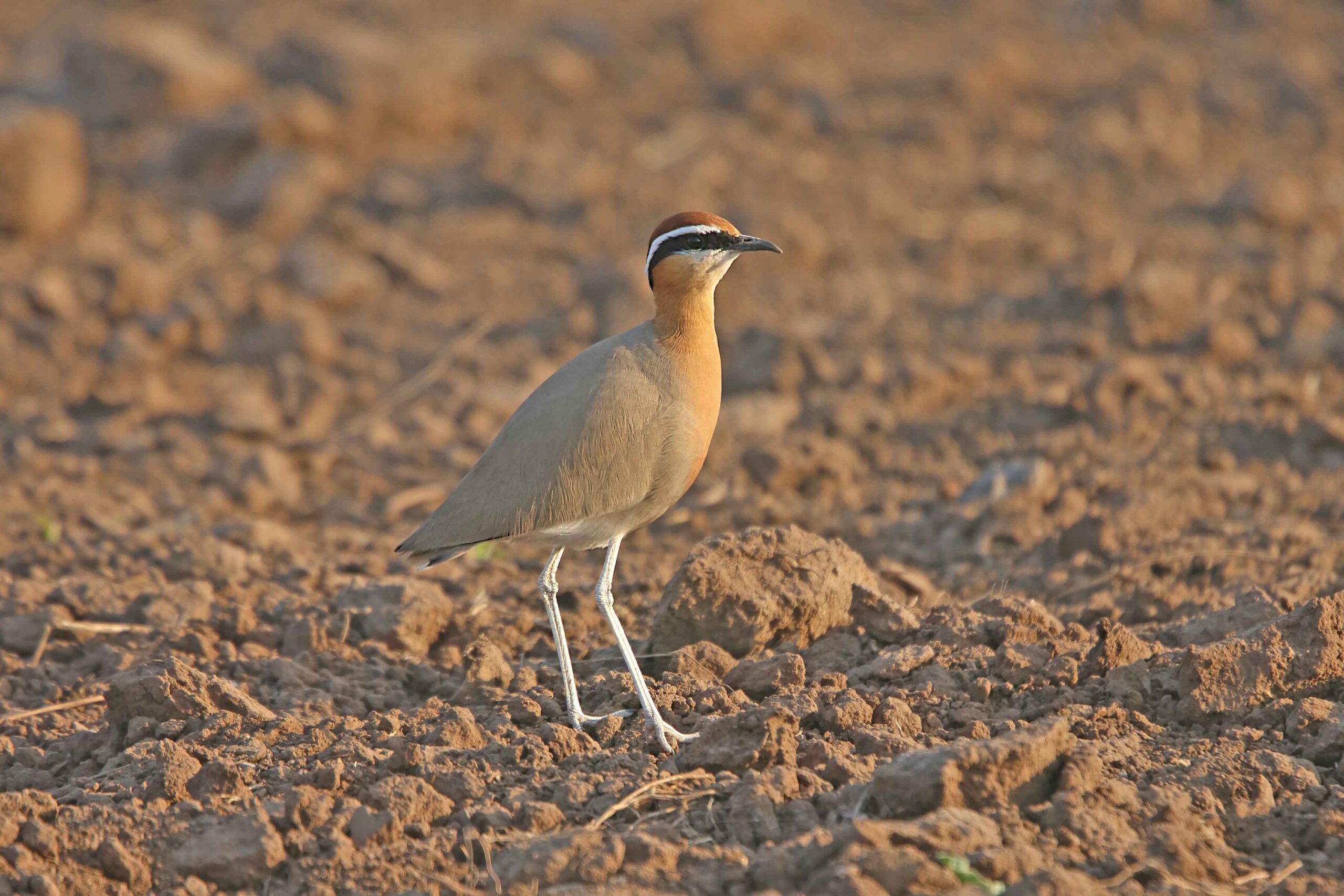
Indian Courser by Sujan Chatterjee
Tour Dates: Saturday 1st – Thursday 20th February 2025 (Delhi to Ahmedabad)
Tour Price: £3,899pp including internal flight but plus international flight
Estimated Flight Price: London to Delhi and Ahmedabad to London approx. £750 return
Deposit: £600 per person
Conservation Donation from Wise Birding: £200
Minimum Number: 6 people
Maximum Group Size: 6 people
Target Birds:
Indian Spotted Creeper, Black Francolin, Great Indian Bustard, Macqueen’s Bustard, Painted Sandgrouse, Sarus Crane, Indian Eagle-Owl, Indian Courser, Crab Plover, Indian Skimmer, Laggar Falcon, White-browed (or Stoliczka’s) Bush Chat, Brown Rock Chat, Yellow-eyed Pigeon, Grey Hypocolius, Rufous-fronted Prinia, Jungle Prinia, Green Avadavat, White-spotted Fantail, White-naped Tit, Indian Yellow Tit, Marshall’s Iora, Sykes’s Warbler, Grey Junglefowl, Rufous-tailed Lark, Syke’s Lark, White-bellied Minivet and plenty more!
Target Mammals:
Asiatic Lion, Indian Leopard, Jungle Cat, “Desert” Asiatic Wild Cat, Striped Hyena, Indian Wolf, Blackbuck, Indian Gazelle (Chinkara), Asiatic Wild Ass (Onager), Spotted Deer, Sambar Deer, Nilgai, Four-horned Antelope, Indian Desert Jird, Indian Porcupine, Northern Plains Grey Langur and more!
This tour covers the key birding sites in North West India and despite a couple of long travel days, we enjoy a number of two and three night stays at key sites to maximise our time for key target species. We visit some fabulous protected areas and National Parks including Desert National Park and Gir National Park and many spectacles await us with thousands of Demoiselle Cranes, hundreds of Crab Plovers and many rare species such as Great Indian Bustard, Indian Spotted Creeper, Indian Skimmer, White-browed Bush Chat and many more! Then of course there are the mammals which we will also make an effort to find with iconic species like the beautiful Blackbuck and the Asiatic Lion in addition to rarer more secretive species like Asiatic Wild Cat and Striped Hyena, both of which we hope to see.
Accommodation: 19 nights in India
1 night Delhi, 1 night Tal Chappar, 1 night Bikaner, 1 night Phalodi, 3 nights Jaisalmer, 1 night Mount Abu, 2 nights Little Rann of Kutch, 3 nights Greater Rann of Kutch, 1 night Jamnagar, 3 nights Sasangir (Gir NP), and 2 nights Velavadar NP
Meals: All meals starting with breakfast on day 2 to breakfast on day 20
Transfer to hotel and rest. Overnight Delhi
Day 2: Birding Delhi and flight to Jaipur
We will spend the morning doing some optional easy birding in and around Delhi before taking an afternoon flight to Jaipur.
On arrival into Jaipur we will drive for around 4 hrs to Tal Chappar. Overnight Tal Chappar
Day 3: Full day in Tel Jappar Wildlife Sanctuary
At Tal Chappar Wildlife Sanctuary our major target will be the endemic Indian Spotted Creeper, which we have a very good chance of seeing. We also have our first opportunity to try to find the range restricted White-browed (or Stoliczka’s) Bush Chat and we will also look for the impressive Black Francolin. Raptors are still common in this part of India and we can expect to find Egyptian and Griffon Vultures, Cinereous Vulture, Eastern Imperial Eagle, Laggar Falcon and maybe also Red-necked Falcon. Passerines typical of the Thar Desert we should see include White-eared Bulbul, Great Grey Shrike, Variable and Desert Wheatears, the near-endemic Brown Rock Chat, Common Babbler and Brahminy Starling. Tal Chappar’s key purpose for becoming a wildlife reserve was to protect the large population of India’s most impressive antelope, the magnificent Blackbuck. Whilst birding we will make a special effort to see these beautiful mammals. After some very enjoyable birding, we will then transfer to our accommodation. Overnight Bikaner
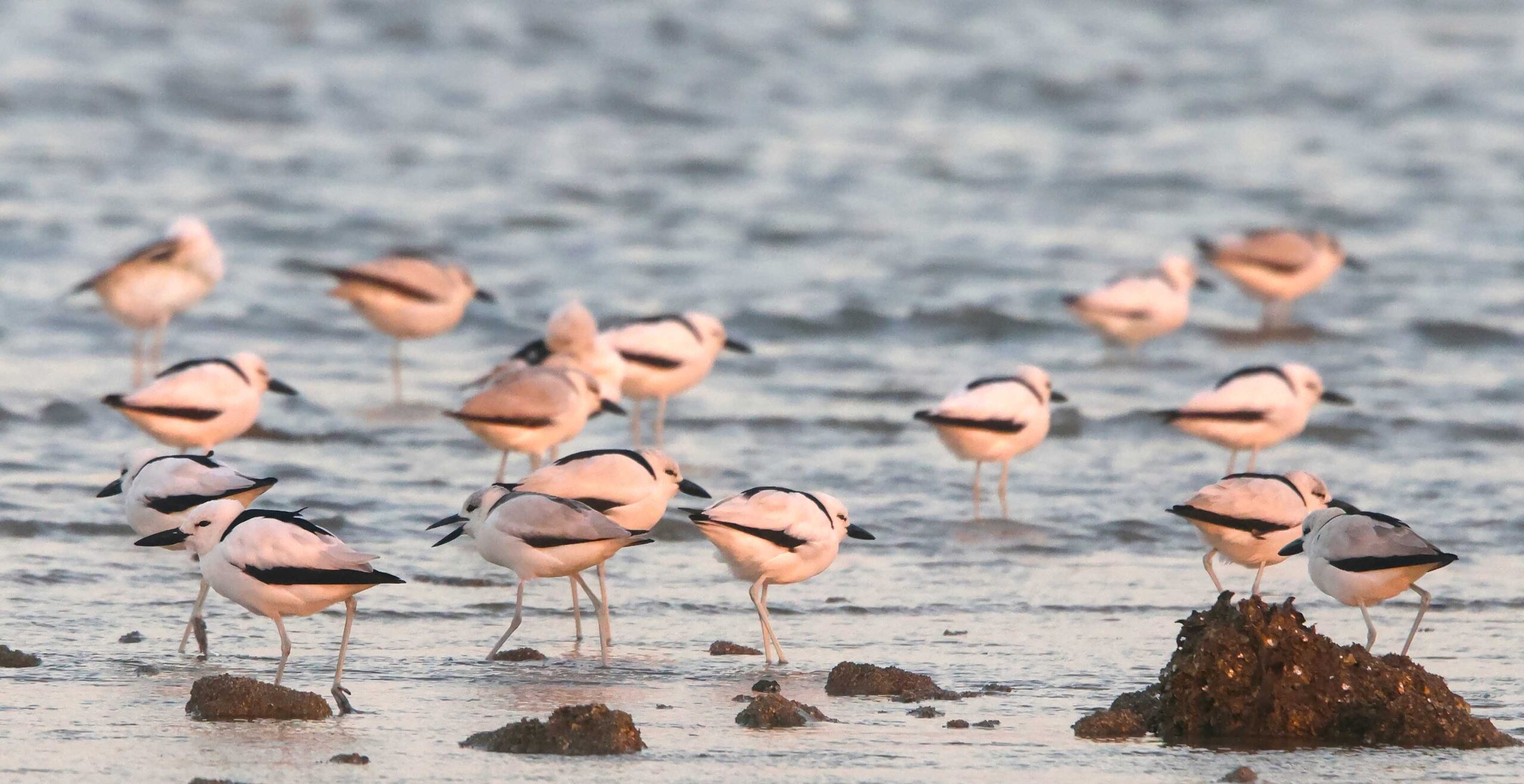
Crab Plovers by Sujan Chatterjee
This morning we will visit an area outside Bikaner that attracts large numbers of wintering Yellow-eyed Pigeons from Central Asia, a species which is sadly declining. We should also see numerous Steppe Eagles, Black Kites and other raptors at roost, providing extraordinary views and photographic opportunities. From Bikaner, we then head south-west to the small village of Khichan near the town of Phalodi. At Khichan during the winter months, thousands of Demoiselle Cranes congregate here from the steppes of Central Asia and Mongolia. This amazing event owes its existence to the custom of the people of Khichan who put out grain for the cranes on the edge of the village. At any one time between 3,000-8,000 Cranes gather around Khichan, making for a really impressive spectacle. Overnight Phalodi
Day 5: Phalodi – Jaisalmer
This morning before breakfast we will again enjoy the spectacle of the Cranes arriving from the nearby rooftops. After breakfast we will head off for the desert city of Jaisalmer. It is a long journey and so today is mostly a travel day, but we will be sure to make a few roadside birding stopes to break up the journey. We will still arrive in daylight and have time for a little local exploring and birding in the immediate new area. Overnight Jaisalmer
The main focus of the next two days will be birding in the Desert National Park to the southwest of Jaisalmer. Here a large fenced area protects the natural grassland and scattered trees and bushes from excessive grazing by cattle. The primary role of the park is to protect the huge and highly endangered Great Indian Bustard, a number of which still occur in the area, both inside and outside the park. Seeing these impressive Bustards wandering across the desert landscape will certainly be one of the highlights of our journey through India’s arid northwest. The species is declining fast and is not as easy to find in the area as it once was, so two days at Jaisalmer (and a backup third morning) is now crucial to giving the best chance of success with this ‘mega-bird’. The other star attraction of the ‘DNP’ is the localized White-browed (or Stoliczka’s) Bush Chat, a species we may have seen already, so this gives us a second chance. Raptors are still fairly common in the area and we may well encounter White-rumped and Red-headed Vultures, Short-toed Snake and Tawny Eagles, Long-legged Buzzard and Laggar Falcon. Other species that we are likely to find include Cream-coloured Courser, Chestnut-bellied Sandgrouse, Black-bellied Sandgrouse, Asian Green Bee-eater, Black-crowned Sparrow-Lark, Bimaculated and Greater Short-toed Larks, Tawny Pipit, Isabelline Wheatear, Delicate Prinia, Asian Desert Warbler, Desert Whitethroat, Isabelline Shrike and Indian Silverbill. We will also visit an area where a few low, sparsely-scrubbed, rocky ridges is good habitat to find the range restricted Rufous-fronted Prinia and Red-tailed Wheatear as well as the more common Desert Lark. Mammal interest in the park is also worthy of attention as Indian Gazelles (or Chinkara) are common in the park. The park is also a good location to find the rare “Desert” Wild Cat. Overnight Jaisalmer
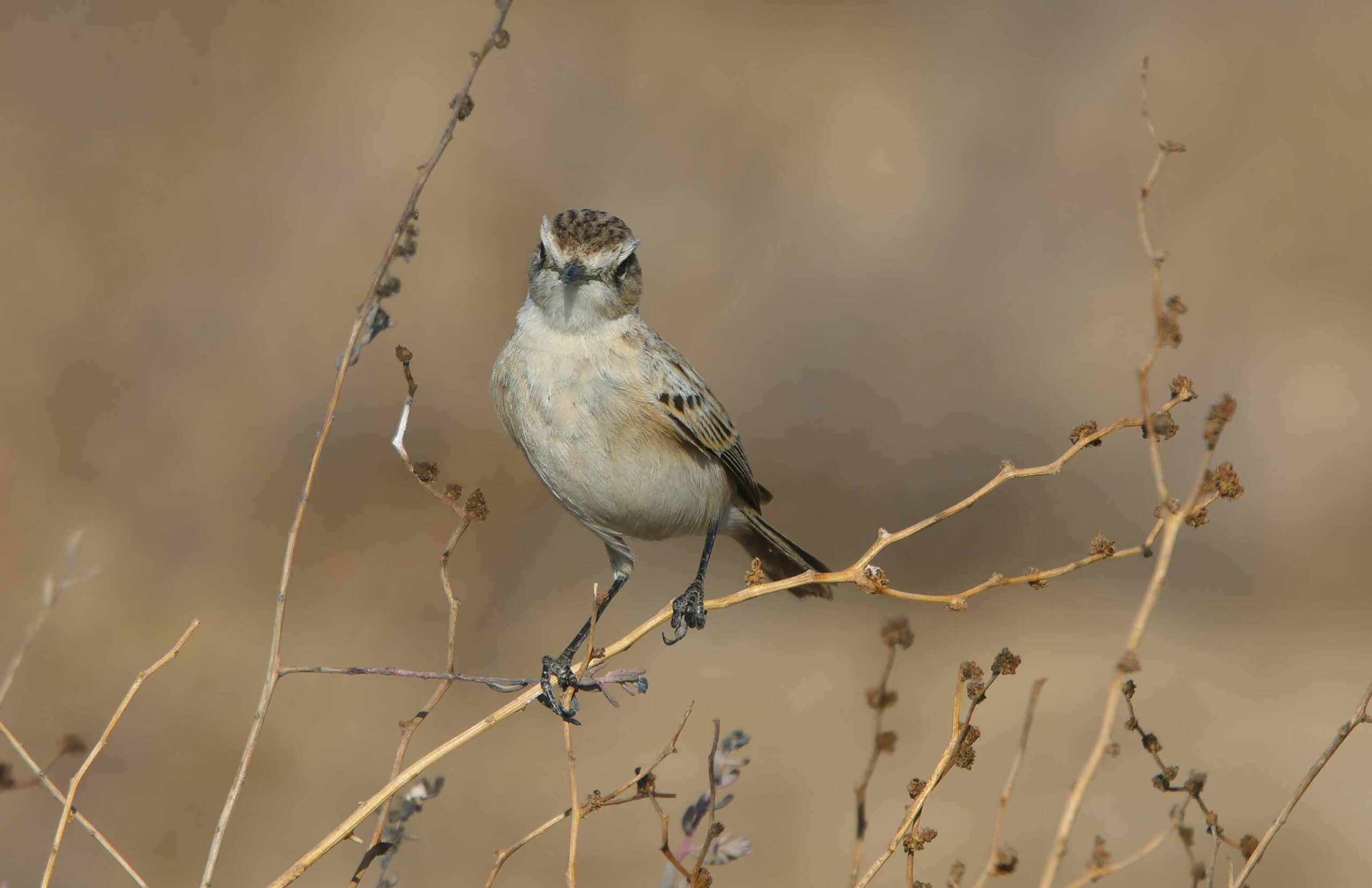
White-browed Bush Chat by Sujan Chatterjee
We will set off early and drive to Mount Abu at the southern end of the Aravalli Mountains. Mount Abu is a small hill station situated below the summit of the mountain of the same name, which at 1,722m is the highest peak in the Aravalli range. Mount Abu is one of the few places in India where the rare and endangered endemic Green Avadavat and we have an excellent chance of finding them here. Other species we hope to see here include Red Spurfowl and Indian Scimitar Babbler, Changeable Hawk-Eagle, Oriental Turtle and Spotted Doves, Alexandrine and Plum-headed Parakeets, Brown-headed and Coppersmith Barbets, Brown-capped Pygmy and Yellow-crowned Woodpeckers, Common Iora, Ashy and Grey-breasted Prinias, Sulphur-bellied Warbler, the endemic White-spotted Fantail, Yellow-eyed Babbler, Cinereous Tit, the endemic Indian Yellow Tit, Indian Jungle Crow, Ashy and White-bellied Drongo, Common Rosefinch and Crested and White-capped Buntings. We will also try for Grey Junglefowl which is tricky to find and a species endemic to Peninsular India that is at the edge of its distribution in this area. Afterwards, we cross into the state of Gujarat. Overnight Mount Abu
Day 9: Little Rann of Kutch Sanctuary
At its southern edge the Thar Desert gradually gives way to the vast saline flats that form the Great Rann of Kutch and the Little Rann of Kutch. The Little Rann of Kutch is the last stronghold of the Indian Wild Ass (or Onager), which is now protected by the 4,954 square kilometres of the Wild Ass Wildlife Sanctuary. We will certainly spend some time looking for these mammals whilst exploring the bushy and grassy areas towards the periphery of this area. We will also be looking for any wintering Macqueen’s Bustards, though sadly numbers have declined due to an extraordinary level of persecution by falconers from Arabia. At the very edge of the Little Rann are some bird-rich wetlands where we are likely to encounter large numbers of Lesser Flamingoes and smaller numbers of Greater Flamingoes. Other birds we should see in this area are Great White Pelican, Dalmatian Pelican, Black-headed Ibis, Woolly-necked Stork, Painted Stork, Asian Openbill, Knob-billed Duck, Common Crane, Sarus Crane, Slender-billed Gull, Gull-billed Tern, a good selection of familiar European waders and with luck, Small Pratincoles. Areas of dry cultivation and wasteland hold two more specialities, the attractive Yellow-wattled Lapwing and the beautiful Indian Courser. Sociable Lapwings also sometimes winter in this area. Other new birds for the trip might include Montagu’s and Pallid Harriers, Common Quail, the near-endemic Rufous-tailed Lark, Crested Lark, Paddyfield Pipit, Pied Bushchat, Rosy Starling and Baya Weaver. Overnight Little Rann of Kutch
Day 10: Little Rann of Kutch
we will have 2 safaris in the Little Rann of Kutch Sanctuary area searching for the many birds and mammals that the area has to offer. Mammals here that we will be looking for aside from Wild Ass include a good chance for Striped Hyena. Overnight Little Rann of Kutch
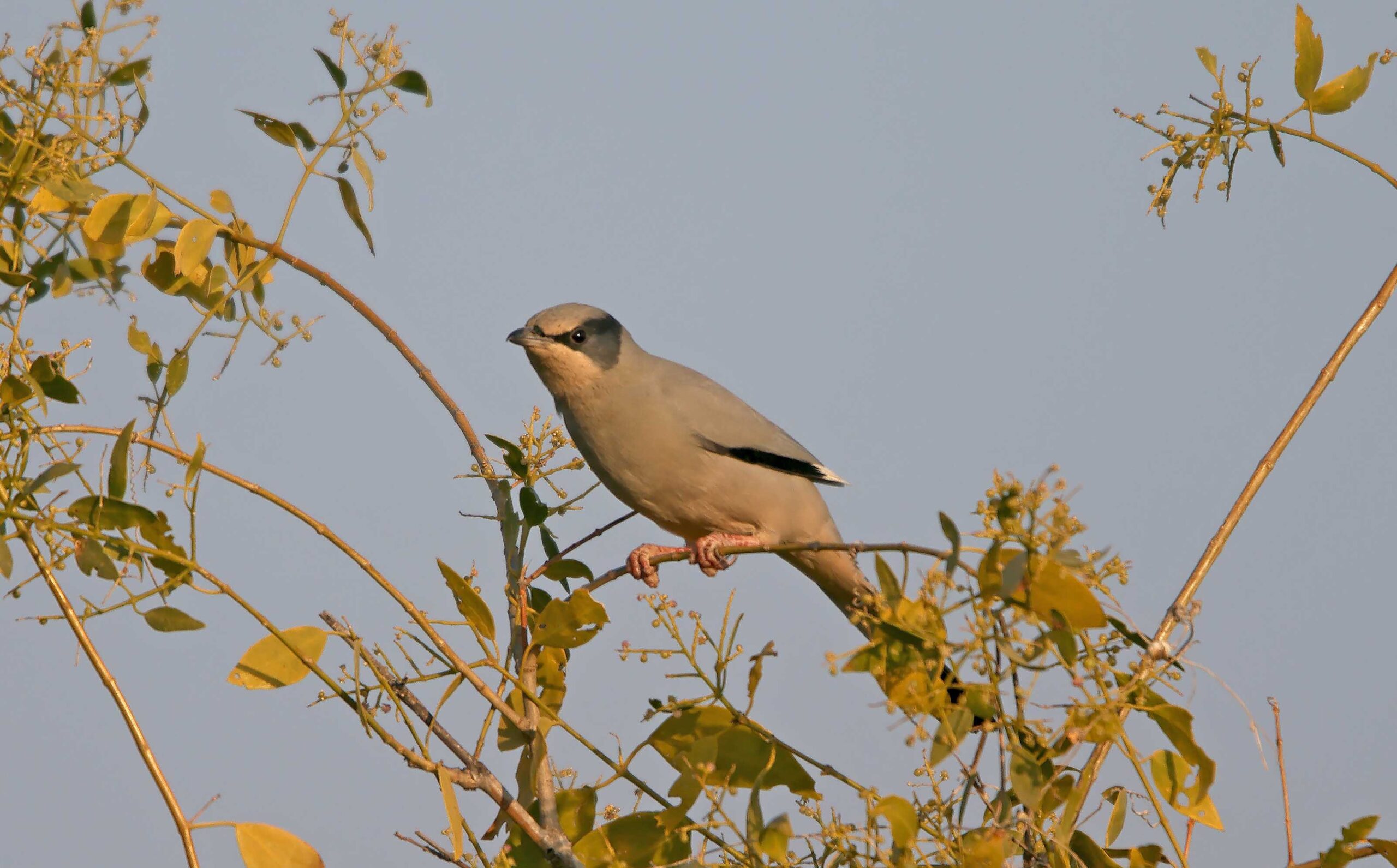
Grey Hypocolius by Sujan Chatterjee
After a final morning safari, we will head westwards to the once-remote but now steadily-modernising region of Kutch. During our journey we will take a detour to the coast where, amongst the sandy beaches and mudflats, we should find the spectacular Crab-plover, the sole member of its family. We will also look for species such as Greater and Tibetan Sand Plovers, Terek and Broad-billed Sandpipers, Great Thick-knees and a reasonable chance of the rare Indian Skimmer. Overnight Greater Rann of Kutch
Days 12 – 13: Two full days exploring Greater Rann of Kutch
Greater Rann of Kutch offers great birding, both inland amidst its largely arid landscapes and along its Arabian Sea coastline. Some very special birds occur here and this is the only part of India where the strange Grey Hypocolius (in its own family) overwinters. We will be visiting a reliable site where the birds gather to feed on small berries, especially early in the morning. Kutch is also famous as the most reliable place to find the handsome, endemic but now rare, declining and endangered White-naped Tit. We know several good areas of dry acacia woodland where this species occurs, so we should be able to admire these rarely-seen birds as they forage amongst the trees, regularly uttering their characteristic calls. The uncommon and localised Indian-endemic Marshall’s Iora is surprisingly easy to find in this same habitat. A fourth speciality passerine of Kutch is the uncommon Sykes’s Lark, another Indian endemic which favours grassy and rocky areas. Just to add to the excitement, wintering Sykes’s Warbler is regularly found in the woodland and Grey-necked Buntings winter here in good numbers. We also have further chances for Painted Sandgrouse, Indian Eagle-Owl and White-bellied Minivet, should we have missed any of these earlier. The uncommon Jungle Prinia is another target in this area. Overnight Greater Rann of Kutch
Day 14: Long travel day to Jamnagar
After breakfast we will start our long drive for around nine hours (plus en route stops) to reach the next destination of Jamnagar. Overnight Jamnagar
Day 15: Jamnagar – Gir National Park
After breakfast we will spend time birding the coast and enjoying the flocks of Crab Plovers and many other waders and terns. We will then drive for around 220Km but making some birding stops en route before arriving at Gir National Park. Overnight Sasan Gir
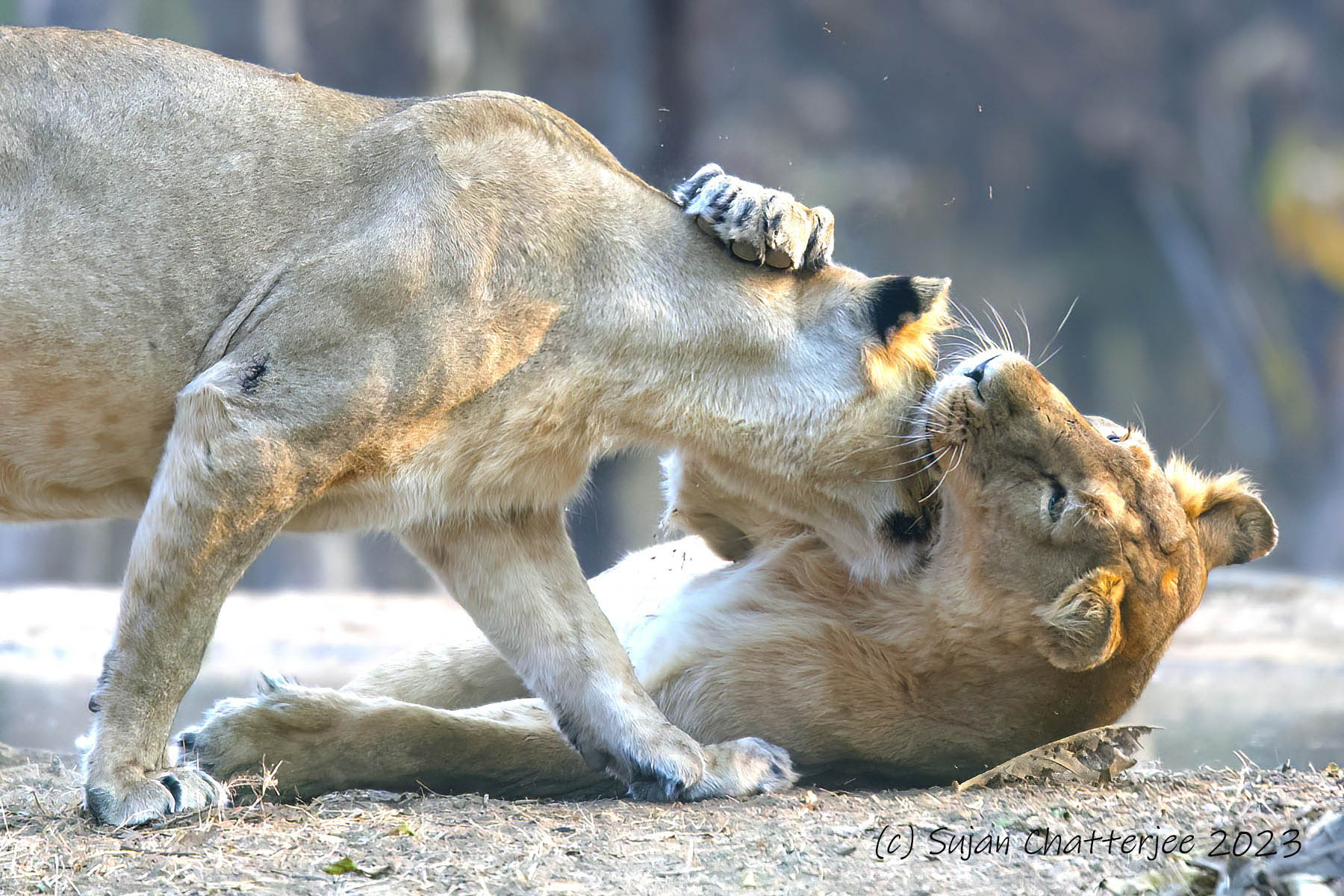
Asiatic Lions by Sujan Chatterjee
We will get into a routine of taking early morning and late afternoon game drives in the park searching for birds and mammals. This means entering the Gir National Park each day for around first light and returning to our hotel during the mid morning when bird and mammal activity is low. We will then rest at the hotel before taking a second safari into the park at around 3pm until dusk. This gives us a total of four visits into the National Park and will maximise our chances for both the bird and mammal target species.
The Gir Forest National Park covers an area of 35,948 hectares with a mix of low hills, grassland, forest and rivers. Of course the Park is perhaps most famous for its population of Asiatic Lions which we will of course focus our time on to see well. The Asiatic Lion is very slightly smaller than the African race and the male Asiatic lion has a relatively short, sparse and darker mane compared to the fuller mane of the African lion. As a result, the male Asiatic lion’s ears tend to remain visible at all times. However, the most distinguishing characteristic of the Asiatic lion is the longitudinal fold of skin that runs along its belly. Unlike in many other National Parks, humans live alongside the wild animals in the Gir Forest and this includes the Maldhari cattle herders and the Lions will sometimes take advantage of this relatively easy prey item. Aside from the Lions other mammals that we will be looking for in the park include Leopard, of which there is a high density of mammals in the park, and it is thought to be one of the best Indian parks to see this cat. Other iconic mammals we might see include Jungle Cat and there is also a chance of seeing the rare Striped Hyena and possibly Asiatic Wild Cat. Large numbers of prey species for predators include Spotted Deer, Sambar Deer, Nilgai, Wild Boar, Four-horned Antelope, Chinkara and Northern Plains Grey Langur.
Of course there will also be plenty of birds to keep us more than interested for these two days and we will be looking for many species. These may include Black-headed Cuckoo-Shrike, Brown Fish Owl, Mahratta Woodpecker and Grey Drongo, Painted Sandgrouse, Jungle Nightjar, Indian Nightjar, Yellow-footed Green Pigeon, Barred Buttonquail, Red-naped Ibis, Crested Honey Buzzard, Red-headed Vulture, Changeable Hawk-Eagle, Indian Scops Owl, Brown Fish Owl, Mottled Wood Owl, Indian Pitta, Marshall’s Iora, White-bellied Minivet, Rufous-fronted Prinia, Tawny-bellied Babbler Yellow-eyed Babbler and many more! Overnight Sasan Gir
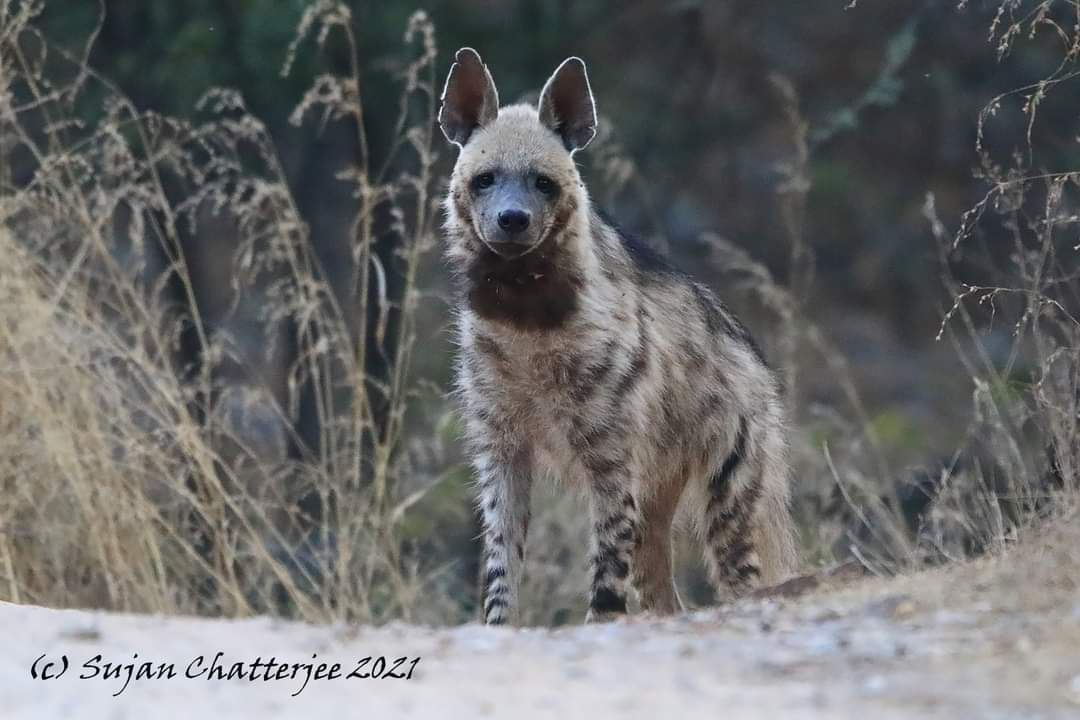
Striped Hyena by Sujan Chatterjee
Today we will travel to Velavadar National Park. It is around six hours drive to the park, but as usual, we will break the journey with birding stops and have lunch en route. Once we arrive at our accommodation we will be in time to take our first safari inside the park. Overnight Velavadar National Park
Day 19: Velavadar National Park
Velavadar National Park is just a 10 minutes drive to the entrance and it contains what is probably the highest concentration of Blackbuck in the world. Although we should have seen this beautiful mammal already at the start of the tour, it will be a fitting end to the tour to see it again as the wild population in India has decreased drastically over the last century. Other mammals we will be looking for in the park may include Wolf, Jungle Cat, Indian Fox and another good chance for Striped Hyena!
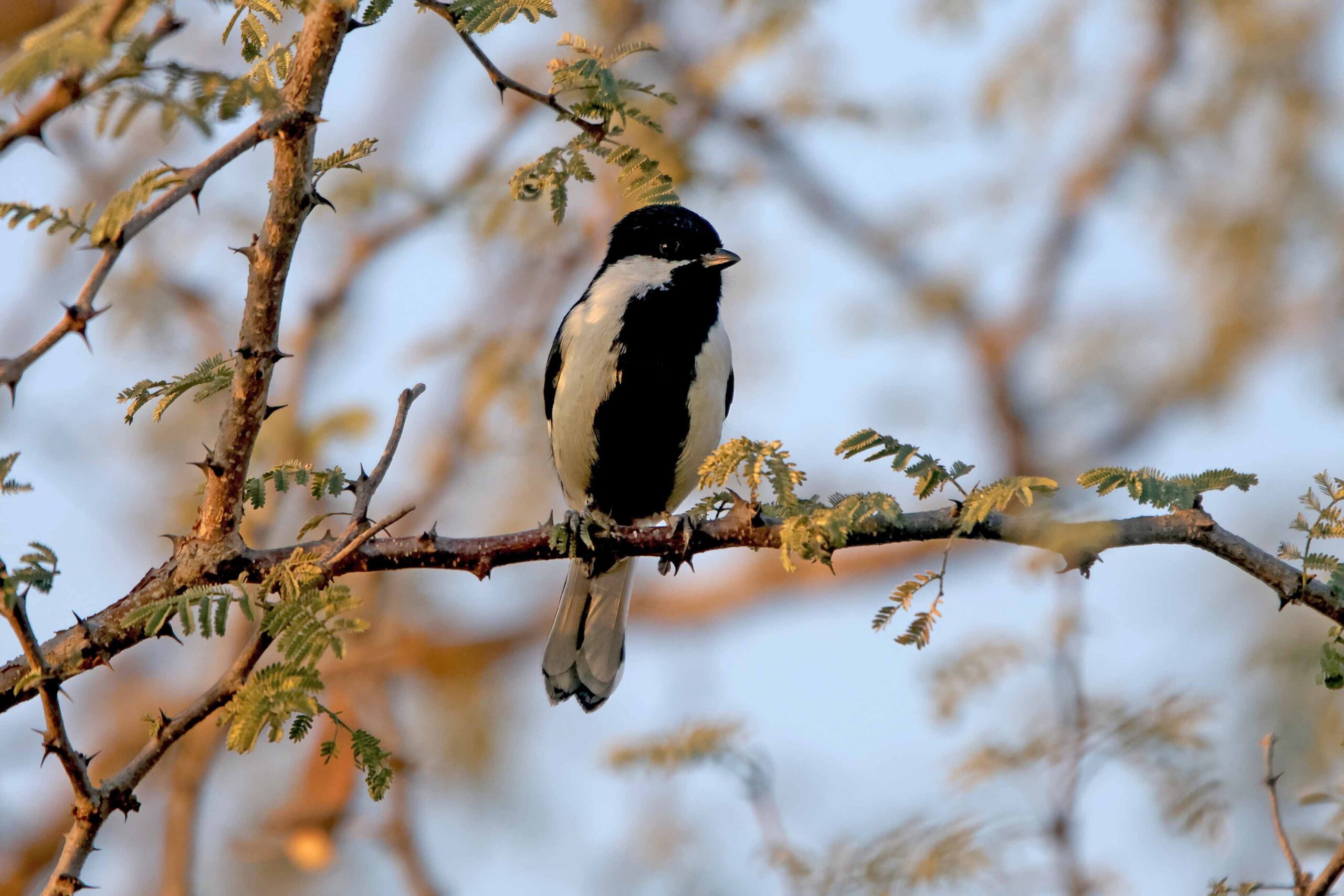
White-naped Tit by Sujan Chatterjee
We will drive to Nal Sarovar for a morning’s birding on a boat for some easy relaxed birding. The Nal Sarovar Bird Sanctuary is just 1.5hrs drive west of Ahmedabad. Spread over 120 sq.kms, it is the largest wetland bird sanctuary in Gujarat. The huge lake and the extensive reedbeds and marshes are a real magnet for thousands of wintering waterbirds. We are likely to see impressive numbers of ducks, waders, herons and storks and a chance of Indian Skimmer. We will then take a transfer of around 90 minutes to Ahmedabad where the tour will end and we will take our international flight back home.
Please note this is a flexible itinerary which may need to be adjusted slightly dependent on arrival / departure times, weather conditions and the most recent information from our local guides
Leader: Sujan Chatterjee
Included in cost: Accommodation in twin rooms, all meals as outlined in above itinerary, bottled water, all ground transport, boat trip, internal flight, any park fees and services of leader.
Not included in cost: International airfare, travel insurance, all drinks other than water, and any airport/visa fees and camera fees in parks.
Single Supplement: We do recommend sharing on this tour as single supplements are pricey in this region. Alternatively single occupancy is £680.
Transport: Minibus and safari vehicles
Difficulty: Easy. Walking is easy going with short leisurely walks on open trails and walking distances of up to 6Km a day.
Climate: The average daily temperatures for February depend ending on the region average between 15°C and 29°C. Rain is of course possible.
Tour Start Point: Indira Gandhi International Airport, New Delhi India
Tour End Point: Ahmedabad Airport, India
Suggested Airlines: British Airways

Indian Skimmers by Sujan Chatterjee